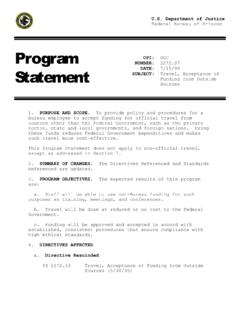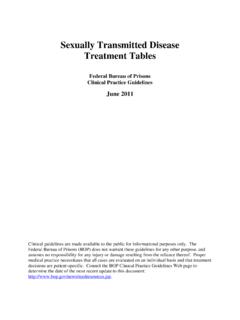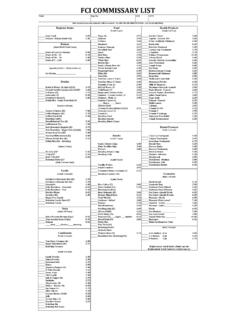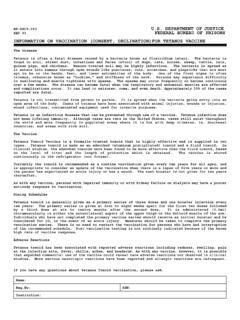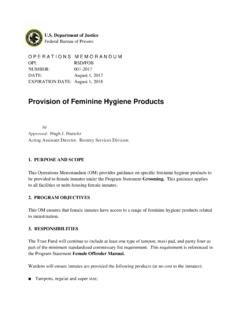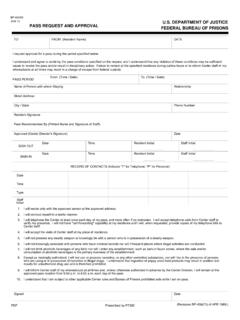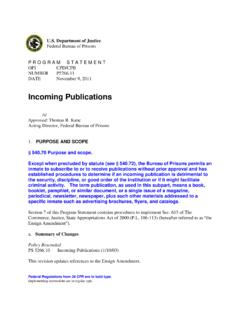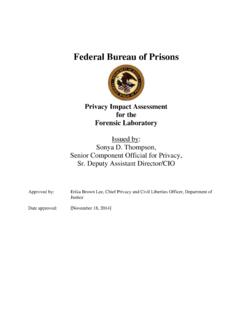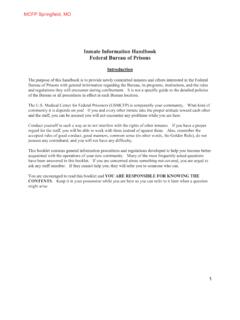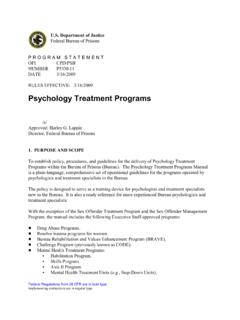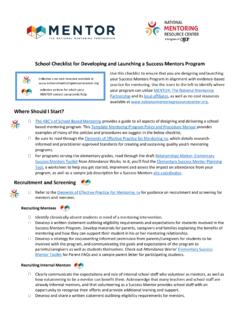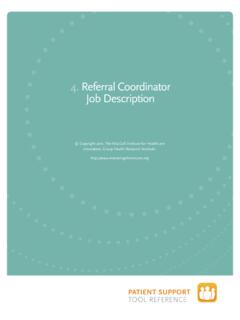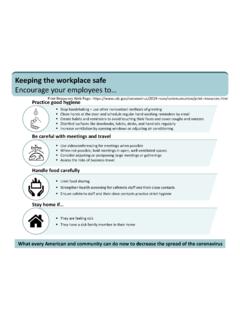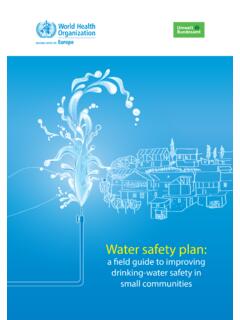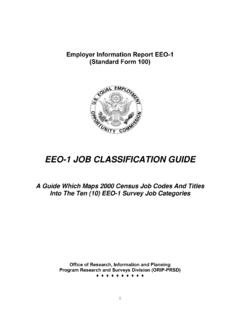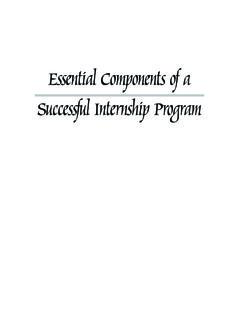Transcription of First Step Act Approved Programs Guide
1 Department of Justice Federal Bureau of Prisons Washington, DC Reentry Services Division January 2022 First Step Act Approved Programs Guide The Federal Bureau of Prisons (Bureau) protects public safety by ensuring federal inmates receive relevant and meaningful reentry programming to support their return to the community as law-abiding citizens. Reentry efforts increase opportunities, reduce recidivism, promote public safety, and reduce institution misconduct. To this end, the Bureau is committed to provide a robust menu of Programs to address thirteen need areas for a diverse inmate population, located in 122 institutions of varying security levels across the nation.
2 January 2022 The First Step Act (FSA) Approved Programs Guide is a collection of the Bureau s robust reentry Programs , designed to ensure all sentenced inmates have the skills necessary to succeed upon release. The Approved Programs are standardized across institutions, described in the Bureau s national policies, implemented with dedicated resources, and regularly reviewed to ensure program fidelity. Standardized Programs in the FSA Guide have fully developed and evaluated protocols that must be adhered to as written. The FSA created two different categories of Programs : Evidence-Based Recidivism Reduction (EBRR) Programs and Productive Activities (PAs).
3 The FSA requires the Bureau to implement a risk and needs assessment system. Risk refers to the likelihood that each individual inmate will reoffend or recidivate after release. PATTERN calculations identify who is most at risk, measured as high, medium, low or minimum risk of recidivism. Need refers to the specific areas an inmate can address to lower his/her risk. In other words, need indicates what issues affect an inmate s risk and what he/she should address by taking Programs . The Bureau assesses needs in 13 areas that directly impact one s ability to live a healthy and productive life. Specifically, these areas are Anger/Hostility; Antisocial Peers; Cognitions; Dyslexia; Education; Family/Parenting; Finance/Poverty; Medical; Mental Health; Recreation/Leisure/Fitness; Substance Use; Trauma; and Work.
4 Inmates are recommended to enroll in the Approved Programs designed to address their individual needs. As outlined in the FSA, eligible inmates earn First Step Act Time Credits (FTCs) for the completion of Approved EBRR Programs and PAs. Inmates may not earn FTCs if serving a sentence for a disqualifying conviction listed in the statute. FTCs currently apply to inmates convicted in Federal District Court only. They do not apply to military prisoners, state boarders, or inmates with a final order of deportation. At this time, FTC's do not apply to inmates convicted in DC Superior Court. The FSA Guide describes structured, curriculum-based Programs led by staff, contractors, or volunteers that may result in the award of FSA time credits.
5 However, inmates may also earn FTCs through participation in unstructured PAs that are not listed in this Guide when these PAs are recommended to address their needs. Program recommendations are based on the individual risk and needs assessment. The FSA Guide provides information on program description, hours of program credits, institution locations, needs addressed, and the responsible department(s) or staff for program delivery, ( , Education, Psychology, Special Populations Programs Coordinator, Reentry Affairs Coordinator). For locations noted as "available at all BOP institutions," this means the program can be offered anywhere.
6 Programs will vary based on the needs of the sentenced population of those locations. Similarly, some Programs have pre-requisites or other required admission criteria. For additional information on these Programs , contact the Reentry Services Division (RSD) by sending an email to More specific inquiries about these Programs should be directed to the responsible disciplines identified in the Program Delivery section of each program. The FSA Guide will be updated at a minimum annually by the Reentry Services Division. TABLE OF CONTENTS EVIDENCE BASED RECIDIVISM REDUCTION (EBRR) Programs # ANGER MANAGEMENT 4 APPRENTICESHIP TRAINING 5 ASSERT YOURSELF FOR FEMALE OFFENDERS 6 BASIC COGNITIVE SKILLS 7 BRAVE* 8 BUREAU LITERACY PROGRAM 9 CERTIFICATION COURSE TRAINING 10 CHALLENGE PROGRAM* 11 COGNITIVE PROCESSING THERAPY 12 CRIMINAL THINKING 13 DIALECTICAL BEHAVIOR THERAPY 14 EMOTIONAL SELF-REGULATION 15 FEDERAL PRISON INDUSTRIES 16 FEMALE INTEGRATED TREATMENT (FIT)
7 * 17 FOUNDATION 18 ILLNESS MANAGEMENT & RECOVERY 19 LIFE CONNECTIONS PROGRAM 20 MENTAL HEALTH STEP DOWN PROGRAM* 21 MONEY SMART FOR ADULTS 22 MONEY SMART FOR OLDER ADULTS 23 NATIONAL PARENTING FROM PRISON PROGRAM 24 NON-RESIDENTIAL DRUG ABUSE PROGRAM 25 POST-SECONDARY EDUCATION 26 RESIDENTIAL DRUG ABUSE PROGRAM (RDAP)* 27 RESOLVE PROGRAM 28 SEEKING SAFETY 29 SEX OFFENDER TREATMENT PROGRAM NON-RESIDENTIAL 30 SEX OFFENDER TREATMENT PROGRAM* 31 SKILLS PROGRAM* 32 SOCIAL SKILLS TRAINING 33 STAGES PROGRAM* 34 THRESHOLD PROGRAM 35 VOCATIONAL TRAINING 36 WOMEN S BASIC FINANCIAL LITERACY PROGRAM 37 WOMEN S CAREER EXPLORATION SERIES 38 STRUCTURED, CURRICULUM-BASED PRODUCTIVE ACTIVITIES 39-49 BOP INSTITUTION INDEX 50-51 RDAP LOCATIONS 52 *RESIDENTIAL (MODIFIED THERAPEUTIC COMMUNITY) ANGER MANAGEMENT DESCRIPTION Anger Management is a cognitive-behavioral curriculum designed to help individuals better manage their anger.
8 The protocol can be used as a 10-session group or in an individual format. The curriculum and journal are available in English and Spanish and are gender-responsive. The journal is designed to be used in group or individual treatment by individuals who have demonstrated a need for learning skills to manage strong emotions such as anger. It provides participants with a summary of core concepts, worksheets for completing between-session challenges, and space to take notes for each of the sessions. The concepts and skills presented in this treatment protocol are best learned by interactive practice, review, and by completing the between-session assignments.
9 HOURS This program is typically completed in 18 hours. LOCATIONS Available at all BOP institutions. NEEDS Anger/Hostility and Cognitions PROGRAM DELIVERY To ensure program fidelity and proper credit, Anger Management must be delivered by Psychology Services staff. January 20224 APPRENTICESHIP TRAINING DESCRIPTION The Bureau s Career Technical Education (CTE) program falls under three broad categories: 1) Apprenticeship Training, 2) Certification Course Training, and 3) Vocational Training: Apprenticeship training prepares the student for employment in various trades through structured Programs underneath a journeyman in that trade, Approved at the state and national levels by the Bureau of Apprenticeship and Training, Department of Labor.
10 Generally, these Programs require inmates to have completed the high school equivalency, but concurrent enrollment is sometimes possible. Each individual program is designed to enhance post-release employment opportunities by providing inmates with the ability to obtain marketable, in-demand employment skills. Programs follow standardized work processes with related trade instruction, which teaches specific job skills and leads to a Department of Labor apprenticeship certificate. A large variety of standardized Department of Labor apprenticeships are offered throughout the Bureau and are highly encouraged; inmates may participate in 2,000 to 8,000 hour Programs , which are supervised by local journeymen.
